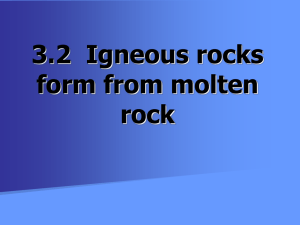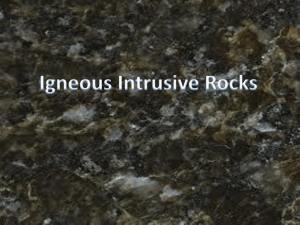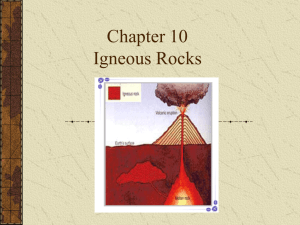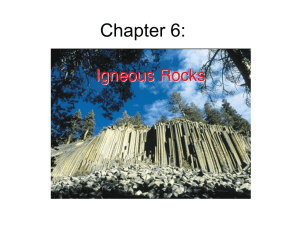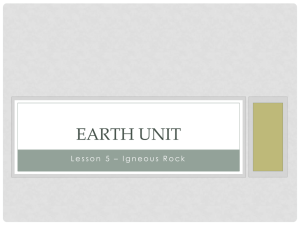Igneous Rocks
advertisement
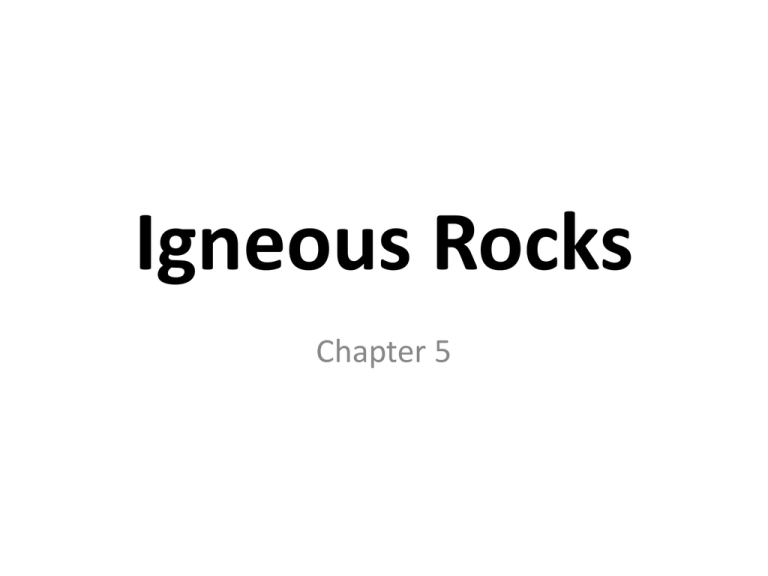
Igneous Rocks Chapter 5 Vocabulary • Radioactivity-the spontaneous process through which unstable nuclei emit radiation. • Lava-magma that flows out onto Earth’s surface. • Igneous rock- rocks formed from the crystallization of magma. Vocabulary • Partial melting- the process by which some minerals melt at low temperatures while other remain solids. • Fraction crystallization- the process by which different minerals from at different temperatures. • Bowen’s Reaction Series- a model that describes the relationship between cooling magma and mineral formation. Composition and Origins of Magma I. Composition of magma A. Magma is a mixture of molten rock, gases, and mineral crystals. B. The elements in magma are the eight major elements in Earth’s crust. 1. The most abundant compound in magma is Silica (SiO2). C. Magmas are classifies as basaltic, andesitic, and rhyolitic. 1. Their classification depends on how much silica they contain. Composition and Origins of Magma Temperature Increase with depth In Earth’s crust. This is known as the geothermal gradient. Water content As this increases, the melting point decreases. Pressure Factors in the formation of magma Increases with depth under the surface Which increases the melting point of rock Mineral content Different minerals have different melting points. How Rocks Melt When a rock begins to melt, the minerals with the lowest melting point melt first. The elements in these minerals from the liquid part of magma. As other minerals melt, the elements in those minerals are added to the magma and change its composition. The opposite happens as the magma cools. The elements in the minerals are removed from the magma in the order that the minerals crystallize, which is fractional crystallization. Bowen’s Reaction Series Partial Melting Partial melting is when different minerals within a rock melt at different rates. When different minerals are melted new elements are added to the magma mixture changing the chemical composition. Synthesize Both branches show that minerals from in predictable patterns in cooling magma. However, in the right branch, the feldspar minerals undergo continuous change. The ironmagnesium minerals, in the left branch, undergo abrupt changes. Section 5.2 Vocabulary Magma- molten material found under Earth’s surface. Intrusive Rock- Igneous Rock that cool slowly beneath Earth’s surface. Extrusive Rock- Igneous rock that cool quickly on Earth’s surface. Granitic Rock- Light-colored rock high in silica and contains quartz and feldspar. Basaltic Rock- Dark-colored rock low in silica and contains iron and magnesium-rich materials. Section 5.2 Vocabulary Cont. Texture- the size, shape, and distribution of crystals or grains that make up a rock. Porphyritic texture- characterized by large, wellformed crystals surrounded by finer-grained crystals of the same mineral or different minerals. Vesicular Texture- A spongy appearance caused by broken gas bubbles Pegmatite- veins of extremely large grained minerals. Kimberlite- a rare, ultramafic variety of peridotite that forms pipe like structures and which sometimes contain diamonds. Types of Igneous Rock Intrusive Extrusive Igneous Rocks - Fine-grained -Cool slowly Formed by - Cool quickly crystallizat -Form - Form above ion of beneath surface magma surface - Ex. Rhyolite Ex. granite -Coarsegrained Mineral Composition 1. basalt: ___________________________ A fine-grained rock containing _______________________________ plagioclase, feldspar, biotite, pyroxene, _______________________________ amphibole, and olivine A felsic extrusive, noncrystalline rock 2. obsidian: ______________________________ rock that contians only 3. peridotite: A_________________________ pyroxene and olivine __________________________ coarse-grained rock that is mostly 4. diorite:A____________________________ white, gray, and black ____________________________ 5. pegmatite: a_________________________ very coarse-grained rock that __________________________ contains potassium feldspar Grain Size Describe the conditions that cause igneous rocks to form large grains or no visible grains. Intrusive igneous rocks are formed when magma cools slowly beneath Earth’s surface, so large crystals have time to form. Extrusive igneous rocks cool quickly because they are exposed to air and moisture on Earth’s surface, so visible crystals do not have time to form. Igneous Rocks as resources List two characteristics of igneous rocks that make them good building materials. 1. They have interlocking grain textures, which give them strength. 2. They contain minerals that are resistant to wearing. Ore Deposits The fluid from which Magma crystallizes Contains high levels Silica, water, and of ______________ Leftover elements ________________. The fluid fills ___________ Cracks, and ___________ Voids in the ________. rock The fluid solidifies to form Quartz veins containing ____________ gold Metals such as _____, silver ____, lead _______, copper and _______, Rare elements such as ________ lithium and __________. beryllium Answer the synthesize question. Other Information Igneous is Latin for “from fire”

